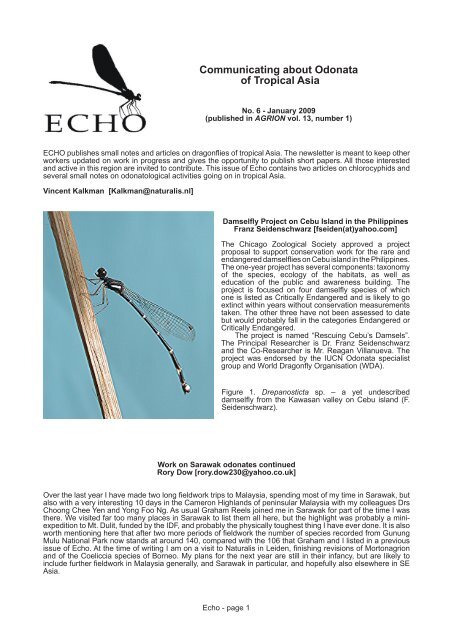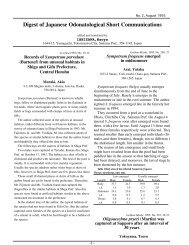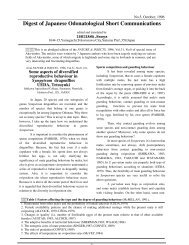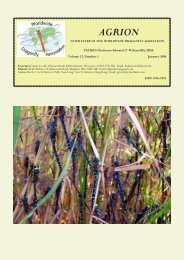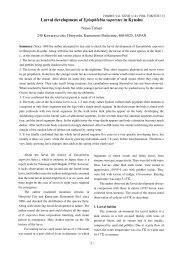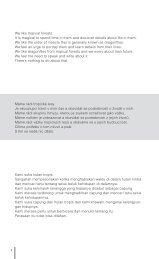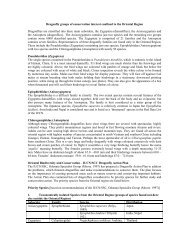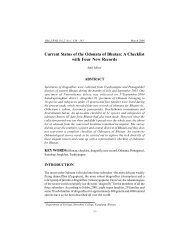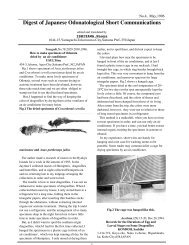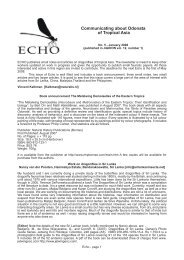ECHO n°6 - Asia Dragonfly
ECHO n°6 - Asia Dragonfly
ECHO n°6 - Asia Dragonfly
Create successful ePaper yourself
Turn your PDF publications into a flip-book with our unique Google optimized e-Paper software.
<strong>ECHO</strong> publishes small notes and articles on dragonflies of tropical <strong>Asia</strong>. The newsletter is meant to keep other<br />
workers updated on work in progress and gives the opportunity to publish short papers. All those interested<br />
and active in this region are invited to contribute. This issue of Echo contains two articles on chlorocyphids and<br />
several small notes on odonatological activities going on in tropical <strong>Asia</strong>.<br />
Vincent Kalkman [Kalkman@naturalis.nl]<br />
Communicating about Odonata<br />
of Tropical <strong>Asia</strong><br />
No. 6 - January 2009<br />
(published in AGRION vol. 13, number 1)<br />
Damselfly Project on Cebu Island in the Philippines<br />
Franz Seidenschwarz [fseiden(at)yahoo.com]<br />
The Chicago Zoological Society approved a project<br />
proposal to support conservation work for the rare and<br />
endangered damselflies on Cebu island in the Philippines.<br />
The one-year project has several components: taxonomy<br />
of the species, ecology of the habitats, as well as<br />
education of the public and awareness building. The<br />
project is focused on four damselfly species of which<br />
one is listed as Critically Endangered and is likely to go<br />
extinct within years without conservation measurements<br />
taken. The other three have not been assessed to date<br />
but would probably fall in the categories Endangered or<br />
Critically Endangered.<br />
The project is named “Rescuing Cebu’s Damsels”.<br />
The Principal Researcher is Dr. Franz Seidenschwarz<br />
and the Co-Researcher is Mr. Reagan Villanueva. The<br />
project was endorsed by the IUCN Odonata specialist<br />
group and World <strong>Dragonfly</strong> Organisation (WDA).<br />
Figure 1. Drepanosticta sp. – a yet undescribed<br />
damselfly from the Kawasan valley on Cebu island (F.<br />
Seidenschwarz).<br />
Work on Sarawak odonates continued<br />
Rory Dow [rory.dow230@yahoo.co.uk]<br />
Over the last year I have made two long fieldwork trips to Malaysia, spending most of my time in Sarawak, but<br />
also with a very interesting 10 days in the Cameron Highlands of peninsular Malaysia with my colleagues Drs<br />
Choong Chee Yen and Yong Foo Ng. As usual Graham Reels joined me in Sarawak for part of the time I was<br />
there. We visited far too many places in Sarawak to list them all here, but the highlight was probably a miniexpedition<br />
to Mt. Dulit, funded by the IDF, and probably the physically toughest thing I have ever done. It is also<br />
worth mentioning here that after two more periods of fieldwork the number of species recorded from Gunung<br />
Mulu National Park now stands at around 140, compared with the 106 that Graham and I listed in a previous<br />
issue of Echo. At the time of writing I am on a visit to Naturalis in Leiden, finishing revisions of Mortonagrion<br />
and of the Coeliccia species of Borneo. My plans for the next year are still in their infancy, but are likely to<br />
include further fieldwork in Malaysia generally, and Sarawak in particular, and hopefully also elsewhere in SE<br />
<strong>Asia</strong>.<br />
Echo - page
Work on dragonflies of Peninsular Malaysia by Universiti Kebangsaan Malaysia<br />
Choong Chee-Yen [cychoong@ukm.my] & Ng Yong-Fong [ng_yf@ukm.my]<br />
Centre for Insect Systematics, Faculty of Science & Technology, Universiti Kebangsaan Malaysia<br />
In the last ten months, we conducted a few surveys on dragonfly diversity and distribution in a few lowland<br />
and highland habitats in the Peninsular Malaysia. These included the botanical garden in Melaka, Sungai<br />
Tekala Recreational Forest (Selangor), Cameron Highlands (Pahang) including the adjacent areas in the state<br />
of Perak, Fraser’s Hill (Pahang), Chini Lake (Pahang), Paya Indah Wetlands (Selangor), and Bangi Forest<br />
Reserve (Selangor). For the survey of highland habitats, the altitudinal data is always taken.<br />
The quite recent survey was done in Cameron Highlands on 17-27 September, 2008, and we were<br />
delighted to have Rory Dow to join us for the fieldwork. The fieldwork has been successful and interesting. A few<br />
larvae of Aeshnidae, Corduliidae and Chlorogomphidae were also sampled for rearing. Revisits to Cameron<br />
Highlands will be carried out in future for a more thorough sampling and survey. We will produce a full checklist<br />
for Cameron Highlands.<br />
Together with Zainal Abidin we have secured a small research grant on the study of dragonflies in<br />
Chini Lake. Fadilawati Ali (MSc. student) has been doing the fieldwork in Chini Lake since November 2007.<br />
We try to understand the biology and ecology of the newly described Chalybeothemis chini.<br />
The survey on dragonflies of Bangi Forest Reserve is still on-going. Since the last report of the checklist<br />
for Bangi Forest Reserve in <strong>ECHO</strong> No. 5, a few more species have been recorded i.e. Vestalis amoena/<br />
amethystina (female), Cratilla lineata and Zyxomma obtusum. Therefore, this will add up the Bangi Forest<br />
Reserve checklist to 77 species in total. In October 2008 the first author found many matured Gynacantha<br />
basiguttata larvae at a shady pond in the Bangi Forest Reserve, and he managed to catch a few and successfully<br />
reared them. The larval emergence of G. basiguttata has been documented in a series of photos. The first<br />
author maintains a blog on dragonflies at http://odonata-malaysia.blogspot.com/.<br />
Activities of Reagan Villanueva with a list of species recorded from Balut Island, Philippines<br />
Reagan Villanueva [reaganjoseph@lycos.com]<br />
In the last year I expended my work to ecological aspect of odonates. Currently I am finishing a study to the<br />
impact of chrome ore mining on adult odonata composition and density and I am still working on the impact<br />
on larvae. I am also in the initial phase of a study on the odonata communities in monoculture farm (banana).<br />
I am finishing the description of several new zygopteran species but have trouble making good illustrations.<br />
In 2008 I did fieldwork on the Babuyan and Batanes group of islands to the north of island of Luzon and in the<br />
Northern Sierra Madre Park. Both expeditions were successful and resulted in the discovery of several new<br />
species. The results of the former will be published this year in IDF-reports.<br />
I received some samples of odonata from Dr. Alma Mohagan (Lepidoptera-Central Mindanao University,<br />
Bukidnon) from their chiropteran and lepidopteran study at Balut Island. This small island is volcanic in origin<br />
and situated southeast of Mindanao between Halmahera and Saranggani Province, Mindanao Island. The list<br />
of species recorded is given below. These records are the first dragonflies to be published for this island.<br />
Chlorocyphidae<br />
Rhinocypha colorata (Hagen in Selys, 1869)<br />
Coenagrionidae<br />
Pseudagrion p. pilidorsum (Brauer, 1868)<br />
Teinobasis samaritis Ris, 1915<br />
Corduliidae<br />
Idionyx philippa Ris, 1937 – The Balut island population has very extensive markings on the thorax.<br />
Protoneuridae<br />
Prodasineura integra (Selys, 1882)<br />
Libellulidae<br />
Agrionoptera insignis (Rambur, 1842)<br />
Neurothemis r. ramburii (Brauer, 1866)<br />
Neurothemis t. terminata Ris, 1911<br />
Orthetrum t. testaceum (Burmeister, 1839)<br />
Potamarcha congener (Rambur, 1842)<br />
Trithemis festiva (Rambur, 1842)<br />
The Geelvinkbaai island and the Star Mountains revisited<br />
Vincent Kalkman [kalkman(at)naturalis.nl]<br />
In 2006 I made my first trip to the Indonesian part of Papua. During that trip I collected dragonflies on Japen<br />
Island in the Geelvinkbaai and at Borme, a small village in the Star Mountains of central Papua. In October<br />
2008 I returned to Papua. I visited the sister islands of Biak-Supiori, which are also part of the Geelvinkbaai<br />
islands and visited two other areas in Star Mountains. Based on this new material a faunistic paper on the<br />
odonates of the Geelvinkbaai will be made. The material I now have from the Star mountains still only gives<br />
a scanty impression of the dragonflies of this part of the central mountain range. The 2008-fieldwork in the<br />
Star Mountains resulted in the discovery of at least three new species (Indolestes, Palairgia and Synthemis)<br />
showing that much remains to be discovered.<br />
Echo - page
Libellago indica (Fraser, 1928) deleted from the list of Sri Lankan Odonata (Chlorocyphidae)<br />
Matti Hämäläinen [matti.hamalainen(at)helsinki.fi]<br />
Matjaž Bedjanič [matjaz_bedjanic(at)yahoo.com]<br />
Nancy van der Poorten [nmgvdp(at)netscape.net]<br />
Fraser (1928) described a new subspecies Micromerus lineatus indica, with type specimens from Poona,<br />
peninsular India. Discussing the distribution of indica Fraser wrote: “Laidlaw reports it from Ceylon, Haragama,<br />
July, and remarks on its difference from type lineatus lineatus Burm., from Burma and Siam”. An almost<br />
identical text was included in Fraser’s (1934) Odonata volume in the Fauna of British India series. Thereafter,<br />
this taxon (either as a subspecies Libellago lineata indica or as a full species Libellago indica), has been<br />
included in all published checklists of dragonflies of Ceylon or Sri Lanka and in the recent books by de Fonseka<br />
(2000) and Bedjanič & al. (2007). However, nobody has reported seeing or studying specimens of this species<br />
from Sri Lanka in the last 75 years. The only published doubt regarding its presence in Sri Lanka was that<br />
implied by Lieftinck’s (1971, p. 189) comment “L. indica (Fraser), which is said to occur in Ceylon as well”.<br />
The listing of L. indica as a Sri Lankan species has been based on the following specimens.<br />
1) A male specimen collected at Haragama by E.E. Green on 10 July 1910 and identified by Laidlaw (1924)<br />
as Micromerus lineatus (Burm.). Laidlaw provided an illustration of the colour pattern of the first 4 abdominal<br />
segments (dorsal view) of this specimen and he wrote “This specimen, which I have compared with a series in<br />
Mr. E.B. Williamson’s collection from Candervalay, lacks the yellow tinge of the base of the wing characteristic<br />
of the males of other species from Ceylon. The brilliant canary yellow of the abdomen (segments 2-5) renders<br />
this little species very conspicuous. This species is badly in need of careful examination. Specimens from<br />
Poona and Ceylon differ strikingly from examples from Burma and Siam, & c.” Without studying the specimen<br />
himself Fraser (1928) considered it to represent his new subspecies M. lineatus indica. De Fonseka (2000)<br />
includes ‘Haragama, (7m)’ [July] in the species account of L. indica.<br />
2) A teneral male specimen in The Sri Lanka National Museum in Colombo bearing the labels ‘Madola near<br />
Opanayake. 16-23-II-33’ [16-23 February 1933]. ‘Libellago asiatica indica. Det. Fraser’. [The incorrect name<br />
‘asiatica’ (pro. lineata) is presently crossed out]. ‘Opanayake, (2)’ which de Fonseka (2000) gives as a locality<br />
for indica refers to this specimen.<br />
3) De Fonseka’s (2000) indica account also gives ‘Kantalai, (3, 7, 8)’, ‘Kottawa, (3)’ and ‘Nawalpitiya, (-)’ as<br />
recorded localities for indica. These are the localities (and collecting months) presented by Kirby (1894) for<br />
specimens of ‘Micromerus lineatus’ collected by J.W. Yerbury in ‘Kanthalai, March 8, July 31, Aug. 8, 1892’ and<br />
in ‘Kottawa, April 24, 1892’ and an additional specimen marked as ‘Nawala-pittia (Green)’.<br />
When the history of these ‘indica’ records is evaluated, we must understand that the identifications were made<br />
before 1939 (or were simply assumptions based on earlier identifications before that date) when Libellago<br />
adami was recognized and described as a species.<br />
Reidentifications<br />
1) This old Haragama specimen is not in the collections of Natural History Museum, London (BMNH). If still<br />
available, it may be in the Indian Museum, Kolkata. Laidlaw’s (1924) figure agrees with both indica and adami,<br />
but the sentence in the description: “lacks the yellow tinge of the base of the wing characteristic of the males<br />
of other species from Ceylon” points to adami rather than indica. In mature males of indica the base of wings<br />
is strongly tinted, whereas in adami it is markedly less so. The sentence “The brilliant canary yellow of the<br />
abdomen (segments 2-5) renders this little species very conspicuous” would characterize better the Burmese<br />
males of lineata, which Laidlaw also compared in the same connection, and he is unlikely to have stated this<br />
about the Haragama specimen. Thus we consider the Haragama specimen to represent adami. It should be<br />
noted that both F.C. Fraser and M.A. Lieftinck had collected long series of Libellago specimens at Haragama<br />
in 1932 and 1938, respectively (see Fraser 1939, Lieftinck 1940) and they both found adami (syn. L. miae<br />
Lieftinck, 1940), greeni and finalis there, but not indica.<br />
2) We have recently studied the ‘indica’ specimen from Opanayake preserved in The Sri Lanka National<br />
Museum in Colombo and reidentified it as adami. Although this teneral, incomplete specimen is in a poor<br />
condition and all natural colours have faded, the shape of the pale patches on abdominal segments 2-5 match<br />
better with adami; in indica the patches are larger in lateral view and less angular in shape.<br />
3) We have located a number of Yerbury’s specimens from Ceylon at BMNH and have found them to include<br />
male and female specimens of L. adami and a female specimen of an undescribed species, currently being<br />
described by Nancy van der Poorten. The specimen from Nawalapitiya (collected by Green) was not traced,<br />
but we do not believe it being different from the other specimens in the series studied by Kirby. In his L. indica<br />
account de Fonseka (2000) copied collecting data of the complete ‘Micromerus lineatus’ series verbatim from<br />
Kirby (1894), apparently because some specimens from Ceylon collected by Yerbury had been misidentified<br />
and placed under the drawer label ‘Libellago lineata indica’ at BMNH. However, most of the labels of Yerbury’s<br />
specimens do not include collecting data as detailed as that given by Kirby (1894). In any case, linking these<br />
specimens to indica has proven incorrect.<br />
We are now convinced that all Sri Lankan Libellago indica records are based on misidentified or<br />
Echo - page 3
Fig. 1. Male of Libellago indica, Mattom, Thrissur District, Kerala, South India, 10 April 2007, Photo by F.K.<br />
Kakkassery.<br />
misinterpreted specimens and that this species has never been collected in Sri Lanka. Consequently this<br />
species is deleted from the checklist of Sri Lankan odonates.<br />
It this connection it is perhaps worth reporting that Matti Hämäläinen recently identified a number of old<br />
Libellago specimens from Ceylon in the Selysian collection in the Royal Belgian Institute of Natural Sciences<br />
in Brussels. Among the 22 pinned male specimens were 20 adami (from Candalay, Haragama, Kandis and<br />
‘Ceylon’) and 2 greeni (Candalay and ‘Ceylon’). (The 18 available female specimens were not identified due<br />
to lack of time). The specimens were without any identity labels, but in the greeni specimens the letter ‘F.’ had<br />
been added to the locality label. This might mean a preliminary identification as ‘finalis’. It should be noted that<br />
there are no specimens of Libellago finalis (Hagen in Selys, 1869) in Selys’s collection.<br />
Although the living males of indica and adami (Figs. 1-2) are easy to separate by the colour of the<br />
pale patches in the abdomen (citron-yellow in indica and grass-green in adami), in poorly preserved museum<br />
Fig. 2. Male of Libellago adami, Hokandara, Colombo, Sri Lanka, 22 March 2007. Photo by Michael van der<br />
Poorten.<br />
Echo - page 4
specimens the colour difference may be unclear. The known distribution of L. adami is presented in Fig. 3. L.<br />
indica occurs in peninsular India, where it still is a locally common stream species. Fraser (1934) wrote: “A very<br />
common insect throughout South India, especially in Western Ghats and Deccan”.<br />
Acknowledgements<br />
We are grateful to Dave Goodger (Natural History Museum, London) and Jerry Louton (Smithsonian Institution<br />
National Museum of Natural History, Washington, DC) for information of Sri Lankan Libellago specimens under<br />
their care. Bert Orr made useful comments on the manuscript. Ali Šalamun, Gehan de Silva Wijeyeratne,<br />
Karen Conniff, Sašo Weldt and Amila Salgado have kindly submitted their records of L. adami to be included<br />
in the distribution map. Francy Kakkassery kindly supplied a photo of L. indica for our use. The first author<br />
received support for his study from the SYNTHESYS Project http:/www.synthesys.info/ which is financed by<br />
the European Community Research Infrastructure Action.<br />
References<br />
Bedjanič, M., K. Conniff & G. de Silva<br />
Wijeyeratne, 2007. Gehan’s photo<br />
guide: A photographic guide to the<br />
dragonflies of Sri Lanka. Jetwing<br />
Eco Holidays, Colombo. Available<br />
at http://www.jetwingeco.com/index.<br />
cfm?mid=6&id=57&sid=57&iid=1&se<br />
ction=freedown&li%5C<br />
de Fonseka, T., 2000. The Dragonflies<br />
of Sri Lanka. WHT Publications,<br />
Colombo.<br />
Fraser, F.C., 1928. Indian dragonflies,<br />
Part XXX. Journal of the Bombay<br />
Natural History Society 32: 683-691.<br />
Fraser, F.C., 1934. The Fauna of British<br />
India including Ceylon and Burma,<br />
Odonata, Vol. II. Taylor and Francis,<br />
London.<br />
Fraser, F.C., 1939. Libellago adami, a<br />
new species of dragonfly from Ceylon<br />
(Odonata). Proceedings of the Royal<br />
Entomological Society London (B) 8:<br />
23-24.<br />
Kirby, W.F., 1894. Catalogue of the<br />
described Neuroptera Odonata<br />
(Dragonflies) of Ceylon, with<br />
descriptions of new species. Journal<br />
of the Linnean Society, Zoology 24:<br />
545-566, pls. 41 & 42 excl.<br />
Laidlaw, F. F., 1924. A catalogue of the<br />
dragonflies (Odonata) recorded from<br />
Ceylon, based on material collected<br />
by Mr. E. E. Green, with description<br />
of a new species. Spolia Zeylanica<br />
(47 & 48): 335-374.<br />
Lieftinck, M.A., 1940. On some Odonata<br />
collected in Ceylon, with descriptions<br />
of new species and larvae. Ceylon<br />
Journal of Science (B) 22(1): 79-117,<br />
pl. I excl.<br />
Lieftinck, M.A., 1971. Odonata from<br />
Ceylon. Entomologica Scandinavica<br />
(Suppl.) 1: 188-207.<br />
Fig. 3. Distribution of Libellago adami in Sri Lanka. The map<br />
combines data from Matjaž Bedjanič’s database ‘Distributional Atlas<br />
of the Dragonflies of Sri Lanka’ which includes both published and<br />
unpublished records received from several observers and Nancy<br />
van der Poorten’s database on Sri Lankan Odonata.<br />
Echo - page 5
Introduction<br />
What is the enigmatic chlorocyphid<br />
Rhinocypha stygia Förster, 1897<br />
from Mt Kinabalu, Borneo?<br />
Matti Hämäläinen [matti.hamalainen(at)helsinki.fi]<br />
Department of Applied Biology, P.O. Box 27, FI-00014 University of Helsinki, Finland<br />
Rhinocypha stygia was described by Förster (1897) based on a male and a female specimen from Mt Kinabalu<br />
in northern Borneo. These specimens, as well as the type series of the conspicuous calopterygid Matronoides<br />
cyaneipennis Förster, 1897, were received from the insect dealers Staudinger & Bang-Haas who had acquired<br />
them from John Waterstradt. Waterstradt had visited Mt Kinabalu briefly in March 1895 and in March 1896 sent<br />
local people to collect a large number of insects from the mountain. The male specimen of stygia is described<br />
as having an entirely shining black body: “Téte et thorax noir de velóurs, abdomen noir chatoyant, surtout à<br />
la fin des segments.” The female has quite a typical chlorocyphid colour pattern, with yellow stripes on thorax<br />
and a row of yellow lateral markings along the abdomen.<br />
Laidlaw (1915) described another Rhinocypha species, R. moultoni, from Mt Kinabalu based on a series<br />
of 4 males and 2 females collected by J.C. Moulton in September-October 1913. The male was described as<br />
having conspicuous brick-red markings on the dorsum of the abdomen and yellow lateral markings, but on the<br />
female abdomen the dorsal markings are lacking. Subsequently, in Laidlaw (1920) four additional females from<br />
the same series were discussed, at least one of them being teneral with conspicious broad yellow markings<br />
on the abdomen. The abdomen of this teneral female was illustrated. Laidlaw wrote: “The adult female of this<br />
species resembles that of R. stygia Förster very closely, to judge at least by Förster’s rather brief description.<br />
But the fully adult male is so brightly coloured about the body – much more so than the female – that I do not<br />
think it possible that stygia, which is entirely black about the body, can be merely a very adult specimen of the<br />
same species. The four males of moultoni that I have been able to examine are fully mature, and it is interesting<br />
to find that they retain on the abdomen the colour-pattern characteristic of the teneral female, which is lost in<br />
the mature female. For whereas the male retains the paired dorsal spots of the abdomen from segment 2 to<br />
9 as rich orange-red marks in addition to the yellow paired lateral marks, these dorsal marks are entirely lost<br />
in the fully adult female, but are very conspicuous in newly-emerged females as large lemon-yellow areas<br />
covering about three-quarters of the dorsum of each segment from 2 to 8; fused at their bases with the lateral<br />
system.... So that, whilst not refusing to admit the possibility of R. stygia being the extremely adult stage of R.<br />
moultoni, I do not think it at all likely, and retain here the latter species as distinct.”<br />
Another North Bornean species, the description of which includes comparison with stygia, is<br />
Rhinocypha cognata Kimmins, 1936. Kimmins’ (1936) description was based on two males from Mt Dulit on<br />
10 August 1932. Kimmins wrote: “Among the Oxford University Expedition material are two males which Dr.<br />
Laidlaw suggested might be Foerster’s stygia. They agree admirably in size but differ in colour in one or two<br />
respects. The types should be, I believe, in the Williamson Collection at Michigan, but Mrs. Gloyd, to whom I<br />
wrote, informs me that only the female type can be found. Under the circumstances, I think it wiser to describe<br />
the Oxford University Expedition material as new.” He writes further: “This species very closely resembles Rh.<br />
stygia Foerster, but assuming his description to be accurate, I think that the differences are sufficient to warrant<br />
the erection of another species. Foerster is very insistent that the body of stygia is entirely black, and unless his<br />
example was very badly discoloured, he could scarcely have failed to notice the lateral thoracic bands which<br />
are present in cognata.”<br />
As can be seen from the quotations above, both Laidlaw and Kimmins were somewhat hesitant with<br />
Fig. 1. The labels of the syntype male of Rhinocypha<br />
stygia found wrongly associated with an incomplete<br />
male specimen of Rhinocypha cucullata in Coll.<br />
Selys.<br />
Fig. 2. Painting of the syntype male of Rhinocypha<br />
stygia by Guill. Severin.<br />
Echo - page 6
their taxonomic decisions. Lieftinck<br />
(1954) listed stygia, moultoni and<br />
cognata as good species without<br />
comments on their status. Thereafter<br />
the first doubts on their status may<br />
have been presented by Huisman &<br />
van Tol (1989), who wrote on stygia<br />
and cognata: “both enigmatic taxa,<br />
and not unlikely synonyms”. More<br />
recent publications, raising the need<br />
to resolve the mutual status of stygia<br />
and cognata, include Orr (2001)<br />
and Orr (2003). Indeed Orr only<br />
used cognata in those publications,<br />
because the identity of this taxon could<br />
be readily confirmed, whereas that of<br />
stygia remained uncertain. Dow and<br />
Reels (2008) include R. stygia, but<br />
not R. cognata in their list of Odonata<br />
from Gunung Mulu National Park,<br />
Sarawak.<br />
During my recent visit to the<br />
Royal Belgian Institute of Natural<br />
Sciences in Brussels for the purpose<br />
of studying the type material of<br />
Calopterygoidea in the collections<br />
of Edmond de Selys Longchamps<br />
(1813-1900), I made some interesting<br />
discoveries. I found the labels of<br />
the lost syntype male of R. stygia<br />
associated with a wrong specimen<br />
and a mature pair of R. moultoni from<br />
Mt Kinabalu, both sexes with brickred<br />
patches on the abdomen. I also<br />
discovered a revealing colour painting made of the lost syntype male specimen of stygia. These findings seem<br />
finally to solve this longstanding problem on the mutual status of these three taxa.<br />
Lost syntype male of R. stygia<br />
As already pointed out by Kimmins (1936) and confirmed by Garrison & al. (2003), Förster’s collection (now at<br />
UMMZ, Michigan) includes only the female syntype specimen of stygia.<br />
Rather unexpectedly I found in the Selys collection a badly broken male specimen of Rhinocypha<br />
cucullata Selys, 1873 incorrectly associated with the original labels of the type male of R. stygia (Fig. 1); the<br />
labels are in Förster’s handwriting. This specimen consists only of abdominal segments 1-8 and one wing<br />
glued to the label. It was placed under the identity label ‘Rhinocypha stygia’ together with two other specimens,<br />
which bear Selys’ identification label ‘près. [near] stygia’; neither of them, however, being real stygia.<br />
Selys and the young German zoologist Friedrich Förster (1865-1918) collaborated closely during<br />
the last few years of Selys’ life. Their mutual interest focussed on Indo-australian dragonflies, and both had<br />
independently purchased material from this region from Staudinger & Bang-Haas. Förster’s (1897) paper also<br />
included the description of the first female of Matronoides cyaneipennis, written by Selys as well as Selys’<br />
footnote comparing stygia with its congeners. Evidently Selys had received the male specimen of stygia from<br />
Förster for study and illustration, as indicated by the presence of the specimen’s labels misplaced in the Selys<br />
collection. Unfortunately this specimen seems to have been permanently lost at some phase, perhaps during<br />
illustration (see below for the lost painted female). The type labels must have been associated to the wrong<br />
specimen sometime after Selys’ death in 1900.<br />
However, the story is not as grim as it might have been. Indeed it evokes a curious and ironic<br />
serendipity, for if the type specimen was indeed lost while being illustrated, we have now at least a good<br />
informative illustration of what was lost. Apparently it is not yet widely known among odonatologists that Selys<br />
commissioned colour paintings of all odonate species in his collection, except of Libellulidae (sensu stricto). A<br />
part of this prodigious portfolio (mainly ‘Agrioninae’ in the old Selysian sense) was executed by Selys himself,<br />
but the greater part of the remainder was painted by Guill. Severin. The portfolio includes paintings of R. stygia<br />
male and female (by Severin). The male illustrated (cropped in Fig. 2) undoubtedly depicts the lost syntype<br />
male of stygia. Some remnants of obscure bluish dorsal markings can be seen, so it could well be a somewhat<br />
discoloured mature specimen, and conspecific with cognata. The size of stygia and cognata male given in<br />
their descriptions is exactly the same: hindwing 21 mm, abdomen 16 mm. The painted female stygia specimen<br />
(also without a head) seems not to belong to the type series, since the female syntype still has its head.<br />
The illustrated female stygia could not be traced in the collections, but it is known that Selys also received<br />
specimens from Mt Kinabalu from Staudinger & Bang-Haas; see below.<br />
Syntype female of stygia<br />
Fig. 3. The syntype female of Rhinocypha stygia. Photo by Mark<br />
O’Brien.<br />
Fig. 4. Female of Rhinocypha stygia from Poring, Kinabalu national<br />
park, 18 April 1994, M. Hämäläinen leg.<br />
Mark F. O’Brien kindly sent me some photographs of the syntype female of stygia in UMMZ (Michigan); one<br />
of them is presented here (Fig. 3). The syntype is identical with a series of 4 females, which I collected at<br />
Echo - page 7
Fig. 5. Male of Rhinocypha moultoni from ‘Kina Balu, Borneo,<br />
Stdg.’ in Coll. Selys, furnished with identity label ‘Rhinoc. tenera,<br />
S.’ by Selys (labels not shown).<br />
Echo - page 8<br />
Poring in Mt Kinabalu National Park in<br />
April 1994 and April 2000 (Fig. 4). I had<br />
earlier compared my specimens with<br />
the ‘allotype’ of R. moultoni at BMNH<br />
(London), the other mature female<br />
specimen in Laidlaw’s original type series<br />
and found them to agree in all respects.<br />
Thus, I am inclined to conclude that the<br />
stygia female and the mature female of<br />
moultoni (sensu Laidlaw) must refer to<br />
the same species – stygia.<br />
Stygia, moultoni and cognata:<br />
connections revealed<br />
Laidlaw’s (1920) conclusion (see above)<br />
that the colour of the dorsal side of<br />
abdomen in moultoni female changes to<br />
black during maturation does not seem to<br />
be correct. In Selys’ collection there are<br />
a male (Fig. 5) and a female specimen<br />
(Fig. 6) of moultoni from Mt Kinabalu (also<br />
received from Staudinger & Bang-Haas,<br />
and undoubtedly originally acquired from<br />
John Waterstradt). These specimens<br />
bear Selys’ manuscript name Rhinocypha<br />
tenera, but placed under an incorrect<br />
drawer label ‘Libellago tenuis, Selys n.sp.’<br />
(in Selys’ handwriting). The male is fully<br />
mature and the female at least ‘nearly’<br />
mature. In spite of this, the female has<br />
conspicuous brick-red patches on the<br />
dorsum of the abdomen, as in the male.<br />
There is no sign of the reddish dorsal<br />
colouring disappearing in this female<br />
specimen approaching full maturation.<br />
Fig. 6. Female of Rhinocypha moultoni from ‘Kina Balu, Borneo,<br />
The colour pattern of head and thorax<br />
Stdg.’ in Coll. Selys, furnished with identity label ‘Rhinoc. tenera,<br />
are almost identical to that in stygia, but<br />
S.’ by Selys (labels not shown).<br />
the pterostigmata are distinctly paler than<br />
in stygia female (and in moultoni male),<br />
especially in the hindwing.<br />
Kimmins (1969) selected a male specimen as the lectotype of moultoni. Thus there are no direct<br />
taxonomic consequences of the fact that the two female specimens in the original type series of moultoni studied<br />
by Laidlaw (1915) are not conspecific with the male, but belong to stygia. One of these females in the collections<br />
of BMNH (London) is<br />
labelled as ‘allotype’ of<br />
moultoni. On the other<br />
hand the teneral female(s)<br />
listed and illustrated<br />
in Laidlaw (1920) is<br />
(are) real moultoni. My<br />
published record of<br />
‘apparent moultoni’ from<br />
Poring at Mt Kinabalu<br />
(Hämäläinen 1994) is<br />
herewith corrected to<br />
represent stygia. Also<br />
my photo of ‘moultoni’<br />
female laying eggs (at<br />
Poring in April 2000) in<br />
Orr’s (2003, p. 52, Fig.<br />
57) book Dragonflies of<br />
Borneo shows stygia.<br />
So it seems that<br />
Huisman & van Tol (1989)<br />
were correct in assuming<br />
that stygia and cognata<br />
might be synonyms. Orr<br />
(1996) used the name<br />
stygia for this species<br />
while describing the<br />
territorial behaviour of<br />
some chlorocyphids in<br />
Fig. 7. Rhinocypha stygia male. Borneo, Sarawak, Mt Dulit, Sg. Nuam, 30 March<br />
2006. Photo by Graham Reels.
Brunei. Unfortunately, he did not observe<br />
any courtship or mating, neither has anyone<br />
else reported seeing male and female stygia<br />
together. Based on the small number of<br />
specimens studied, the sexes appear to differ<br />
in size to some extent, females (hindwing<br />
22.5-24 mm) being considerably larger than<br />
males (hindwing 19-21 mm). This is typical for<br />
most chlorocyphids. Photographs of male and<br />
female stygia taken in the field are presented<br />
in Figs. 7-8.<br />
The known range of Rhinocypha<br />
stygia (= cognata) covers north-eastern<br />
Sarawak, Brunei and Sabah. The southern-<br />
and westernmost records are from the eastern<br />
slopes of Mt Dulit. It is rather common at some<br />
locations on Gunung Mulu. In Brunei it is<br />
known only from Kuala Belalong Field Studies<br />
Centre. In Sabah it is known from Poring at<br />
Mt Kinabalu, the Danum Valley and Tabin.<br />
The known altitude range is 100 – 800 m.<br />
Rhinocypha moultoni is much rarer species, so<br />
far it has been recorded only at Mt Kinabalu,<br />
at the altitude range 1000-1550 m. The few<br />
known records have been made in August and<br />
September.<br />
Acknowledgements<br />
I am grateful to Bert Orr, Rory Dow, Graham Reels and Jan van Tol for their useful comments on the manuscript.<br />
Mark O’Brien (UMMZ) kindly provided the photograph of the syntype female of R. stygia. Rory Dow and Graham<br />
Reels allowed me to include their excellent photos taken in the field. My best thanks go also to the museum<br />
curators David Goodger (BMNH), Patrick Grootaert and Jerome Constant (IRSN) for all help received during<br />
my recent visits in London and Brussels. I have received support for my studies from the SYNTHESYS Project<br />
http:/www.synthesys.info/ which is financed by the European Community Research Infrastructure Action.<br />
References<br />
Fig. 8. Rhinocypha stygia female. Borneo, Sabah, Mt Kinabalu,<br />
Poring, 29 April 2005. Photo by Rory Dow.<br />
Dow, R. & G. Reels, 2008. List of species recorded at Gunung Mulu national park, Sarawak, Malaysian Borneo<br />
in 2005-2006. Echo 5: 2-3 (published in Agrion 12(1)).<br />
Förster, F., 1897. Contributions à la faune odonatologique Indo-Australe. Annales de la Société Entomologique<br />
de Belgique 41: 204-211.<br />
Garrison, R.W., N. von Ellenrieder & M.F. O’Brien, 2003. An annotated list of the name-bearing types of<br />
species-group names in Odonata preserved in the University of Michigan Museum of Zoology. Occasional<br />
papers of the Museum of Zoology, University of Michigan 736: 1-73. Available at http://deepblue.lib.umich.<br />
edu/bitstream/2027.42/57172/1/OP736.pdf<br />
Hämäläinen, M., 1994. Dragonflies of Mount Kinabalu (the highest mountain in Borneo). Malangpo 11:77–81.<br />
Huisman J. and van Tol J., 1989. Dragonflies and caddisflies (Odonata and Trichoptera) from waters around<br />
the Danum Valley Field Centre. Sabah Society Journal 9: 90–109.<br />
Kimmins, D.E., 1936. The Odonata of the Oxford University Sarawak Expedition. Journal of the Federated<br />
Malay States Museum 18: 65-108.<br />
Kimmins, D.E., 1969. A list of the type-specimens of Odonata in the British Museum (Natural History), Part II.<br />
Bulletin of the British Museum (Natural History) Entomology 23(7): 287-314.<br />
Laidlaw, F.F., 1915. Contributions to a study of the dragonfly fauna of Borneo. - Part III. A collection made<br />
on Mount Kina Balu by Mr. J.C. Moulton in September and October 1913. Proceedings of the Zoological<br />
Society of London 1915: 25-39.<br />
Laidlaw, F.F., 1920. Contributions to a study of the dragonfly fauna of Borneo. - Part IV. A list of species known<br />
to occur in the island. Proceedings of the Zoological Society of London 1920: 311-342.<br />
Lieftinck M.A., 1954. Handlist of Malaysian Odonata. A catalogue of the dragonflies of the Malay Peninsula,<br />
Sumatra, Java and Borneo, including the adjacent small islands. Treubia 22 (Suppl.): i-xiii + 1-202, 1 map<br />
excl.<br />
Orr A.G., 1996. Territorial and courtship displays in Bornean Chlorocyphidae (Zygoptera). Odonatologica 25:<br />
119–141.<br />
Orr, A.G., 2001. An annotated checklist of the Odonata of Brunei with ecological notes and descriptions of<br />
hitherto unknown males and larvae. International Journal of Odonatology 4: 167-220.<br />
Orr, A.G., 2003. A guide to the dragonflies of Borneo: their identification and biology. Natural History Publications<br />
(Borneo), Kota Kinabalu.<br />
Echo - page 9


